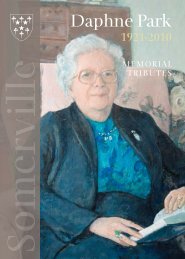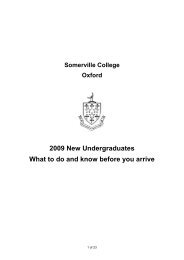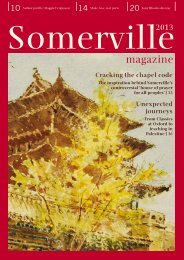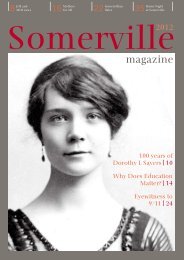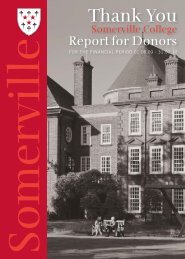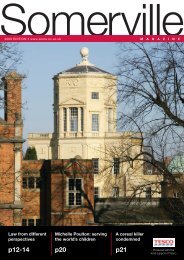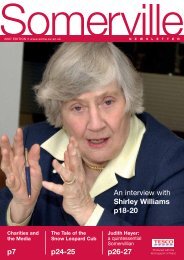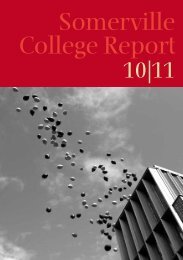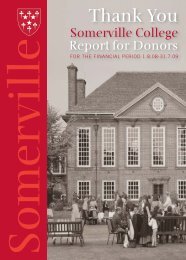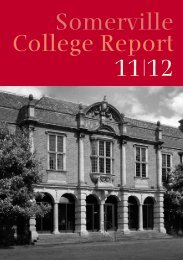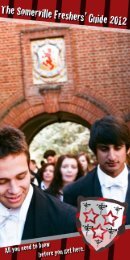magazine - Somerville College - University of Oxford
magazine - Somerville College - University of Oxford
magazine - Somerville College - University of Oxford
Create successful ePaper yourself
Turn your PDF publications into a flip-book with our unique Google optimized e-Paper software.
12 | <strong>Somerville</strong> Magzine<br />
Of Witchcraft<br />
In the last couple <strong>of</strong> years, college travel grants have enabled<br />
students to reach far-flung destinations, such as Australia,<br />
CATHERINE BORG<br />
(2008, Human Sciences)<br />
Medical mysteries in Malawi<br />
A fantastic insight<br />
into the reality <strong>of</strong><br />
anthropological<br />
research in a<br />
place with such a<br />
different culture<br />
from our own.<br />
Why do so many Malawians turn first to traditional<br />
healers when they are ill? Is western medicine less trusted<br />
because it lacks a spiritual dimension? These were the<br />
questions that the Wilma Crowther travel fund helped me<br />
attempt to answer in July and August 2009.<br />
I fi rst found myself asking the questions during my gap<br />
year, when I taught English in one <strong>of</strong> the most rural and<br />
untouched areas <strong>of</strong> Malawi, the Lower Shire Valley. Last<br />
summer I returned with Rosalie Lear, a fellow Human<br />
Scientist from Keble. We stayed in a Catholic mission<br />
in the village <strong>of</strong> Mitumbiri and, with the help <strong>of</strong> a local<br />
translator, arranged several interviews with people from<br />
the surrounding Namitembo parish.<br />
We questioned a diverse cross-section <strong>of</strong> people <strong>of</strong><br />
varying ages and levels <strong>of</strong> education, living within<br />
different distances from the nearest western-style health<br />
clinic, as well as religious leaders, nurses and doctors,<br />
and most importantly, “a’singanga” – traditional healers.<br />
The interviews were very broad to begin with, as Rosalie<br />
and I began to understand who uses traditional healers,<br />
who uses western medicine and who uses both, in<br />
which situations and for which reasons. As we spoke to<br />
more and more people, we gained a greater insight into<br />
the methods used to treat various illnesses.<br />
Most interesting <strong>of</strong> all perhaps was the response to<br />
HIV/AIDS and the methods chosen to work alongside<br />
antiretroviral drugs (ARVs) to prevent its progression.<br />
Whilst there was a general consensus that HIV is an<br />
incurable disease, a wide range <strong>of</strong> remedies were<br />
used by the different healers – including the Moringa<br />
tree. It turned out that Western doctors and nurses<br />
also advocated its use, thanks to its immune-boosting<br />
properties. This is certainly something I would like to<br />
follow up to fi nd out whether the tree is ever used in<br />
European medicine.<br />
We also learnt about the great importance to healing<br />
<strong>of</strong> “ufi ti” – that is, witchcraft – something we hadn’t<br />
anticipated. The experience was a fantastic insight into<br />
the reality <strong>of</strong> anthropological research in a place with<br />
such a different culture from our own, the diffi culties<br />
that come with it, and the need for a great variety <strong>of</strong><br />
techniques to get accurate and useful information.<br />
The opportunity to experience both the biological and<br />
anthropological aspects <strong>of</strong> my course in the fi eld helped<br />
me put into practice what I learnt and read about in<br />
my fi rst year at <strong>Oxford</strong>. I am confi dent it will help me<br />
through the rest <strong>of</strong> my degree too. I am very grateful<br />
indeed to <strong>Somerville</strong> and to the donors <strong>of</strong> the fund. One<br />
day I hope to return to Malawi and further my research<br />
into its ethnographies, particularly the “a’singanga”.<br />
Photo: Rosalie and myself (from I – r) learning to make the staple “nsima” in front <strong>of</strong> a crowd <strong>of</strong> interested villagers



